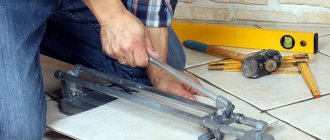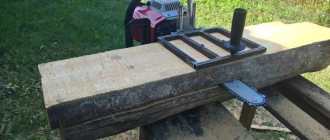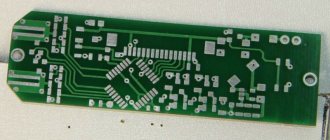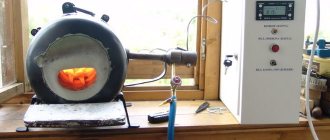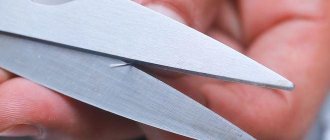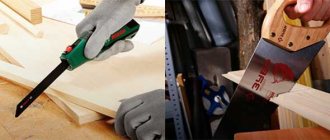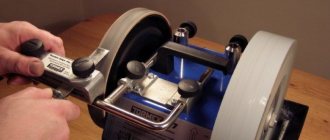Hacksaws of various types are used when performing everyday work on personal plots, cottages, as well as during repairs in which natural wood is used as the main material. The saw requires periodic maintenance. At a certain point, you need to sharpen your wood hacksaw because it has begun to perform its function worse than before. In order not to spoil the blade and return the tool to its former performance, you need to follow a few simple tips.
How to determine when it's time to sharpen a hacksaw
In order not to shorten the service life of the hacksaw blade, it should be sharpened only when it can no longer perform a high-quality cut, or requires more effort when working with it. The main signs of a dull saw are the following:
- the tips of the teeth were rounded, their shape was distorted;
- the sound of the saw changed: there was a feeling that the wood was not being cut, but was being torn along the fibers;
- the cutting speed has decreased compared to the new hacksaw;
- nicks and nicks began to appear on the cut;
- The hacksaw occasionally jams even when cutting smoothly.
If at least one of the listed signs appears, then the hand saw needs servicing. This includes both direct sharpening of the teeth and their correct alignment.
Sharpening hacksaw teeth for crosscutting
To bring back the sharpness of crosscutting tools, it is more effective to use a triangular file with a personal cut and an angle of 60°. After clamping the blunt hacksaw in the setting, begin processing the left edge on the first cutter. It is recommended to fix the blade at an angle of 45-50° relative to the working plane. The file is installed parallel to the surface of the work table at an angle of 60-75 °.
Restorative manipulation of blunt incisors is carried out in several passes. The first step is to sharpen the left edges of the odd cutters, and then the right edges. After passing the odd-numbered cutters, the tool is deployed in the sharpening device to begin processing the even-numbered teeth that are in the far row. When working with crosscut saws, it is important to control the sharpness of the cutting edges.
General requirements for sharpening
Sharpening a hacksaw is a rather painstaking process in which accuracy is important. To make it easier, you should use only good files and needle files that are sufficiently sharp. If you have to sharpen your saw frequently, the best solution would be to have a separate set of tools for this job. Before sharpening, it doesn’t hurt to look at the teeth of the hacksaw. If their shade is darker than the canvas, then they are red-hot. It is impossible to sharpen such a hacksaw on wood.
When sharpening at home, you should remove the metal evenly. An equal number of passes with a file are made on each individual tooth, regardless of how worn it was before correction. In this case, you cannot change the sharpening angle, set by the inclination of the file, or rotate it around its axis. Movements should be made strictly from oneself, since it is with this technology that the efficiency of removing metal from a hacksaw is achieved, and the worker can confidently control the tool in his hands.
To avoid additional difficulties during sharpening, the saw blade should be firmly secured in a vice. It is desirable to have a source of direct light, which will allow you not to peer into the results of the work.
Why sharpen the blade on a hand saw, and when should you do it?
A hacksaw is subjected to various loads during operation, as a result of which the teeth become dull. In addition, they change their position. All this leads to the fact that:
- the efficiency of using the tool decreases;
- it requires spending more time and effort on the sawing process;
- the accuracy and quality of the cut deteriorates (jars are formed);
- there is a danger of using a blunt instrument.
A saw with dull teeth needs to be sharpened. You can determine when it’s time to process the tool by the following factors:
- the hacksaw makes a characteristic sound when working (with constant use it is easy to determine its change);
- the tips of the teeth are rounded;
- the tool has lost its former efficiency and cutting quality.
If these situations arise, sharpening of the tool is necessary.
Teeth setting
It all starts with checking the distance between the teeth. It is designed to prevent the saw from jamming in the cut. It should be adjusted to the type of wood with which you most often have to work. If you have to work with hard wood, the teeth are set apart at a distance 1.5-2 times greater than the thickness of the blade. For soft wood, the teeth of the hacksaw should be set at a distance of 2-3 times greater.
One of the key points when performing routing is maintaining uniformity. If the saw teeth are bent at different distances from the center, this will lead to permanent wedges and deterioration in the quality of the cut and the speed of sawing the wood. Therefore, it is recommended to use a device for setting teeth, which is called “setting”. Thanks to the stop, it is impossible to bend the tooth to a greater distance than provided by the standard.
The teeth are divided into two groups one at a time and are bent sequentially along the entire length of the cutting side of the blade. First, this procedure is carried out for one group, in which the set teeth must be bent in a certain direction, then it is repeated for the opposite direction.
Sharpen, do not dull a hacksaw: instructions for sharpening a hacksaw for wood
Despite the abundance of chainsaws, circular saws, grinders and other automatic cutting tools, the ordinary hand saw is still popular.
While it has long been replaced by more advanced saws in production and logging, the good old toothy blade remains in garages and dachas. A wood hacksaw can last for decades if it is sharpened in a timely manner and correctly.
Even people who regularly work with their hands make mistakes in this process.
Need for sharpening
The most obvious advantage of sharpness is the speed of sawing. When working in the country, this is even more important than in the workshop, since you often have to work in cramped conditions, standing in an awkward position. A poorly sharpened blade gets stuck in wood, especially raw wood. In addition, there is a risk that the canvas will break and injure the worker.
The practical benefits of spiciness include:
- Accuracy of the cuts performed.
- Longer service life of the canvas.
- Savings on replacing hacksaws.
- High productivity of carpentry work.
Determining the right moment
Without experience, people often go from one extreme to another and either sharpen the saw every few days or once a year. Determining the need for sharpening by time is the wrong approach.
There are a number of signs that indicate that the teeth are dull:
- The blade regularly gets stuck in the wood.
- When sawing, the sound changes, it becomes more “dull”.
- The shade of the teeth changes.
- The resistance of the material increases significantly.
- The ends of the teeth are noticeably rounded.
- The blade moves away from the cutting line.
Hardened teeth cannot be sharpened. They are easy to distinguish: they are blackish with a slight blue tint.
Sharpening instructions
First you need to prepare the equipment necessary for work:
- Set of files.
- Sandpaper.
Without a basic set, it’s basically impossible to sharpen it.
To make sharpening better, you can prepare additional tools:
- A device that allows you to mount the saw at the required angle.
- Locksmith's hammer.
Wiring
Before returning the sharpness to the saw, you need to adjust the teeth, that is, move them apart. Setting is the installation of cutting teeth at a certain angle relative to the blade and each other.
If you look at the set saw, you can see that they, alternating, deviate to the right and left from the blade plate itself. This configuration gives the hacksaw freedom to make deep cuts.
It doesn’t get stuck because it doesn’t touch the walls with its entire plane.
The distance between the set teeth should be one and a half or two times the thickness of the hacksaw. They are produced no thicker than 1.5-2 millimeters, therefore, the cutting protrusions need to be set at 0.25-0.5 mm for sawing dry and hard wood; for damp or soft wood you need to bend it by 0.5-1 mm.
To set the correct angle for each tooth “by eye”, you need solid experience, which not every carpenter has. It comes after many dozens of sharpened saws. For less experienced carpenters, there is a tool called a setting tool. Its most primitive version is a flat steel plate with a slot. A hacksaw is inserted into this gap with a minimum gap, under tension.
The wiring process looks like this:
- Secure the hacksaw in a vice like this. It is necessary to ensure that the teeth protrude 2 cm above the jaws.
- The teeth are clamped in the groove and then bent in the middle.
- First you need to bend all the even teeth in one direction, then bend the odd ones in the opposite direction.
- At the end, you can spread the jaws of the vice according to the calculated width of the spread and try to pass the saw between them.
- An excessively bent tooth will hit the vice. Use pliers to bend it a little further.
Adjustment of teeth height
All cutting lugs must be the same size to ensure that sawing performance is not compromised. Longer teeth experience greater stress and wear out faster, while shorter teeth do not even touch the wood.
Pulling the canvas becomes jerky, uneven, and more effort is wasted. The accuracy of the cut deteriorates, the cut surface becomes rougher.
Adjustments are made before sharpening begins. To make sure that none of the teeth protrude, you can do this: press the canvas against a sheet of paper placed on the table.
The tops of the teeth will be imprinted on the sheet, and the gaps in this pattern will allow you to adjust their height. To do this, hold the saw in a bench vise and use a file to file down the teeth that are too long.
Direct sharpening
To return the teeth to their former sharpness, a whetstone used to sharpen kitchen knives is not suitable. You need a special tool: a file with a triangular cross-section or a needle file. It is very good if you have several files with different sections and cut pitches: this will allow you to process each tooth perfectly.
Sharpening stages:
- Hold the file by the handle with one hand and place the other on the end of the tool.
- Decide on the sharpening angle. Usually it is 15-30 °. You can determine it by eye, with a protractor, or use simple equipment. Shape a block of wood into an isosceles triangle with angles of 90, 60 and 30 degrees, then use it as a measuring stick.
- Sharpen the left cutting edges of the even (farthest from you) teeth. Each requires an equal number of file passes to remove the same amount of chips. The pressure on the tool should be equal.
- Turn the hacksaw over to the other side, then sharpen the left edges of the even-numbered teeth again.
- Sharpen the tops of the teeth.
- Do not forget to control the sharpening angle using a whetstone.
The process seems very simple, albeit monotonous, but there are a number of nuances:
- The saw must be secured very tightly in the vise for safety reasons. Do not be afraid to damage the metal of the blade with strong compression.
- The work area should be well lit to make it easier to determine angles and sharpness.
- The metal is removed only when the file moves away from the carpenter.
- The more dull the saw, the larger the notches on the file can be, but to fine-tune the teeth you should always use a file with small notches.
- When fixing the tool in a vice, push it between the jaws as deep as possible. To prevent the hacksaw from swinging outward, only the teeth should remain.
- During the work process, there will inevitably be burrs on the sharpened edges. To remove them, just rub the metal with a fine-grained abrasive (sandpaper).
- To check the quality, you need to carefully examine the teeth in the light. They should shine.
Sharpening quality improvements
How do you sharpen a hacksaw for wood?
On your own From a master
The classic option that anyone can use was discussed above. There is a way to make the sharpening process more efficient and easier.
When using a multi-axis vice with a rotating frame, you can fix the blade so that you only have to move the file in the horizontal plane.
You can purchase a special sharpening device at a hardware store. It is attached to the workbench with a clamp and the hacksaw is clamped in it at angles of 90 and 45 degrees relative to the working surface. After installation it will be much easier to use the file.
Conclusion
I tested various sharpening methods in my own experience. In the garage there was an old wood saw that had not been sharpened for probably twenty years. It served as a testing ground for me. I won’t say that the saw is like new, but it can work in the country without any problems.
There is nothing difficult about sharpening saws yourself; you just need to get your hands used to it. My father once taught me how to sharpen saws, but he did everything in a simple way, without fixing the blade in a vice. This is the wrong approach. You should always clamp the saw in a vice. Firstly, it’s safer, and secondly, it’s easier.
Height alignment
After the setting has been completed, the hacksaw needs to be checked to ensure the same height of the teeth. Since the force may have been applied unevenly, there is a chance that teeth with less wear will appear that will protrude above the rest.
To identify such teeth on a hacksaw, you can use a simple method. It will require thick paper or cardboard along the length of the cutting blade. The sheet should be placed on a flat surface, such as a table, leveled well, and then the cutting part of the sheet should be pressed against it with force. Teeth that are out of alignment will make deeper indentations on the surface.
Thanks to this, they can be easily detected and corrected before sharpening begins. To remove excess height, various needle files are used. While performing this work, you should strive to preserve the shape of each hacksaw tooth as much as possible.
Device for setting saw teeth
Using a wrench without a factory-made stop (A) it is difficult to set the teeth of the saw well. What did I come up with?
I took a piece of steel (2 mm), cut out (see drawing) part (B), bent it at an angle of 90 degrees using a mowing line aa, drilled a hole in the center and made a thread for a 6 mm bolt. I drilled two holes with a diameter of 4 mm in the plate and the key and riveted them together. The photo shows a modified key. Using a bolt and lock nut, I set the desired saw tooth angle.
With such a device, wiring takes just a few minutes.
Vladimir Babushkin Based on materials from the Toloka newspaper. We do it ourselves"
- A Secure Grip for Unruly Plugs If you've ever had to remove a drilled-out wood plug from a hole saw, you know how difficult it can be to remove it without damaging it.
Essential sharpening tool
To perform such a seemingly simple operation, you will need a rather impressive list of tools. However, if one of them is not at hand, you can try to find a replacement for it. What you cannot do without is a workbench with a vice, since only with their help can the saw be firmly fixed for work. The rest of the list looks like this:
- a “wiring” device, which, if missing, can be replaced with high-quality pliers. In this case, you will have to determine the approximate distance from the center for each tooth;
- a sharpening stone with sandpaper or a set of needle files and files;
- hammer;
- additional light source;
- In some cases, a caliper and protractor may be needed to take accurate measurements.
Special mention should be made of the method of sharpening hand saws using a grinder. In this case, you will need to have the angle grinder itself, a workbench and a pair of clamps, since the blade will need to be fixed horizontally.
Hand saw wiring methods
This is best done on special equipment - an adjustable machine. Using an indicator, you can determine the correct deviation of the tooth, so the work can be done in a matter of minutes.
If the machine is difficult to find, you can open the hacksaw manually. However, performing the procedure will take a lot of effort and time, and besides, you cannot do without a special tool - wiring, which you can make on your own. It is a metal plate with a sawn groove 1.5 mm wide and 5 mm high. The saw is clamped in a vice and with this groove the tooth of the tool is grabbed and moved in the desired direction.
This must be done in a certain order. First, the teeth are deflected through one in one direction, then the rest in the other. In this case, there should be no distortions, and the teeth should be straightened symmetrically. It is not the entire tooth that bends, but only its top (that is, its third part), otherwise it may break. The width of the setting should be equal to twice the thickness of the blade; if the teeth are set too wide, the hacksaw will be difficult to move, and too much wood will go into the sawdust. In addition, if the tool is set incorrectly, the tool will “wedge” and an even cut will not work.
You can also open using a screwdriver or chisel. The tool is placed between the teeth and rotated; before this, the saw should also be clamped in a vice.
Do-it-yourself saw sharpening
The saw is prepared for sharpening by fixing it in a vice, the jaws of which should ideally be made of wood so as not to damage the surface of the saw. Step-by-step instructions for sharpening a hacksaw on wood with your own hands are as follows:
- The hacksaw is fixed with its teeth as close as possible to the jaws of the vice, but so that their alignment is not disturbed while clamping the driver at an angle of 90° to the surface of the workbench.
- The file is taken into the working hand with the handle, and its tip is held on the reverse side with the other hand. This way the force will be distributed evenly.
- Sharpening a regular hand hacksaw is done at an angle of 15-30° to the tooth. If the wear is not too severe, the “original” sharpening angle will be clearly visible.
- The angle of the file to the blade should be about 30-45°. To do this, you need to stand so that the working hand is lower than the auxiliary one.
- The file should move only away from itself, with the same force and number of movements for each tooth. For a sharp file, 3-5 movements are usually enough to straighten the edge of an individual tooth.
- In this way, one side of the canvas is passed, after which it is turned over, fixed in a similar way, and the actions are repeated for the second side.
If, when performing sharpening work, you apply uneven force or make different numbers of movements with a file, this can lead to displacement of the teeth in relation to each other, distortion of their size and shape. Ultimately, such a hacksaw will require professional sharpening, or may even be completely unsuitable for further use.
Classification of hacksaws
- Canvas length. The comfort of work depends on this value (you make fewer reciprocating movements), and the teeth on a long hacksaw do not clog as intensely. The general rule is that the blade for a wood saw should be twice as long as the size of the workpiece.
- Tooth size. The speed and quality of the cut depends on this parameter. Moreover, the criteria are mutually exclusive. A hacksaw with a fine tooth gives a high-quality and clean cut, but the speed is lower and more effort is applied. A large tooth cuts faster and easier, but the edges of the cut will be “ragged” and rough. In the parameters, the tooth size is indicated in “TPI”, the number means the number of edges per 1 inch. The higher the value, the finer the teeth
- Tooth shape. This parameter determines the direction of the cut (along or across the grain), the type of wood, and the vector of the applied force (from yourself or towards you). Of course, there are universal canvases. Proper sharpening of a hacksaw is carried out in accordance with the shape of the tooth
- Blade steel type. Classification of material is a separate topic; we are interested in the processing method. The canvas can be hardened, not hardened or combined. In the latter case, only the teeth are hardened. This can be determined by the shade of the metal - hardened steel is darker.
This “disadvantage” is compensated by the slow process of dulling. If you don’t come across a nail or a hard knot, the hardened blade will last a long time. True and the price is appropriate.
Sharpening with a grinder
If you wish, you can speed up the process by using a power tool. To do this, you will need to secure the saw blade horizontally so that its teeth protrude slightly beyond the edge of the workbench using several clamps. The tighter the fixation, the less errors in sharpening due to vibration will be. Before using the grinder, you should perform the same preparatory operations as in the case of manual sharpening, namely checking the setting and height of the teeth.
To remove the metal layer, not grinding, but cutting abrasive discs are used. The fact is that the spacing between the teeth is small, and it is impossible to place a thick disk there without damaging the adjacent tooth. Cutting wheels with a thickness of 0.8-1.5 mm will be optimal.
When performing work, it is mandatory to use protective equipment, at least special glasses and gloves. This will protect you if the cutting wheel is damaged. The shield must also be mounted in the correct place.
The disc must be carefully passed in the space between each tooth, sharpening first one side and then the other. In this case, you need to be quite good at handling an angle grinder, since the sharpening angle and the amount of metal removed is controlled only by the worker himself. If you have doubts about the success of such a project, it is better to first experiment with an old hacksaw that you won’t mind ruining in order to get better at it.
Device for setting saw teeth
Setting the cutting edge in different directions eliminates the possibility of the blade getting stuck during operation. An example is the case when, when cutting a thick log, the blade cannot be moved and pulled out. Also, the saw can jam due to the heating of the metal and its expansion, the burning part can heat up the resin and turn it into a kind of glue.
READ Hammer Cracks and Doesn't Turn How to Fix
You should use a device for setting the teeth of hacksaws in order to avoid similar problems. We should not forget that mistakes made during work can lead to huge dilemmas. You can perform the function in question by using the following tools:
- There are special mechanisms. They allow you to manually shift the individual parts relative to each other. It is worth considering that a similar version is made for certain products.
- In most cases, mechanical wiring is used. They allow you to change the angle of position, as well as their width. This tool is characterized by higher efficiency in use.
- The improvised version is not intended for working with a hacksaw on wood, but can be used for this. An example is pliers and other improvised tools found in virtually every workshop.
If sawing is carried out frequently, then experts advise purchasing a special device that allows you to quickly set the required angle.


